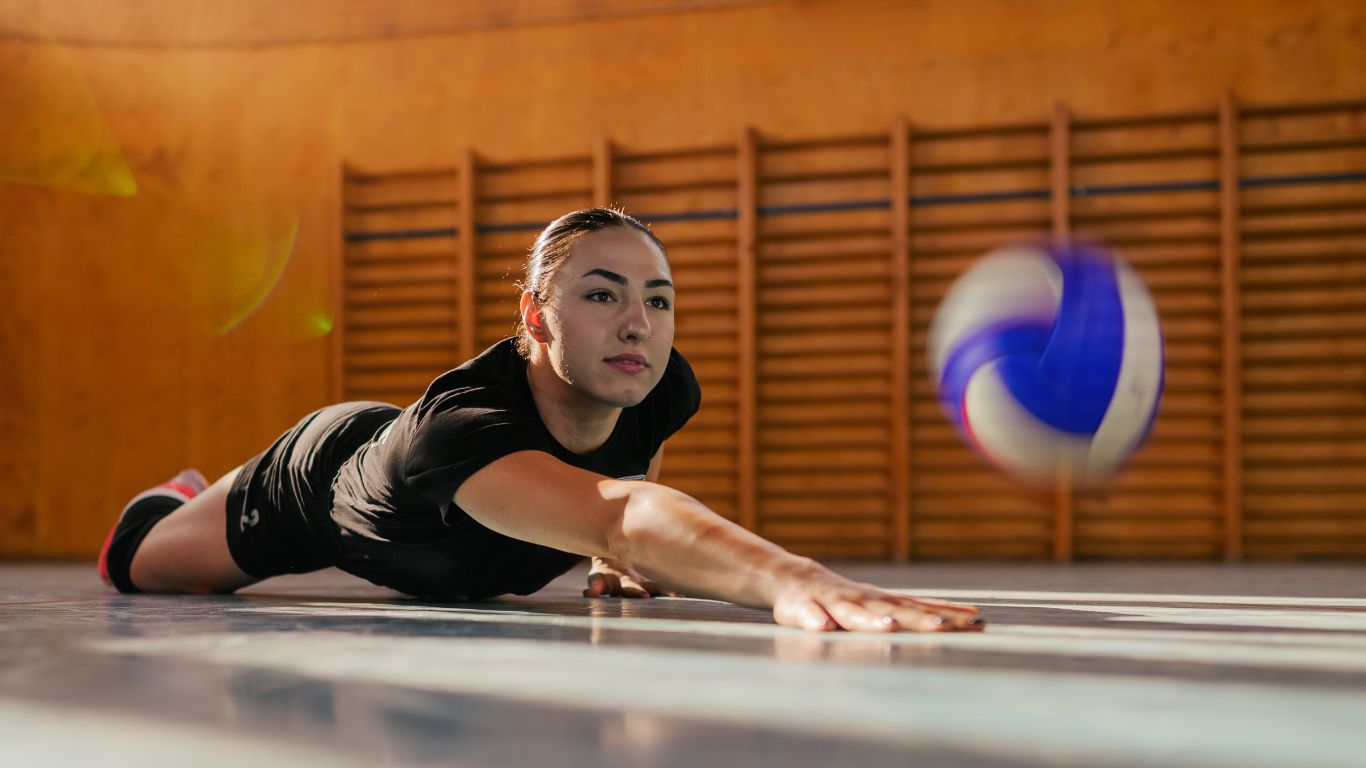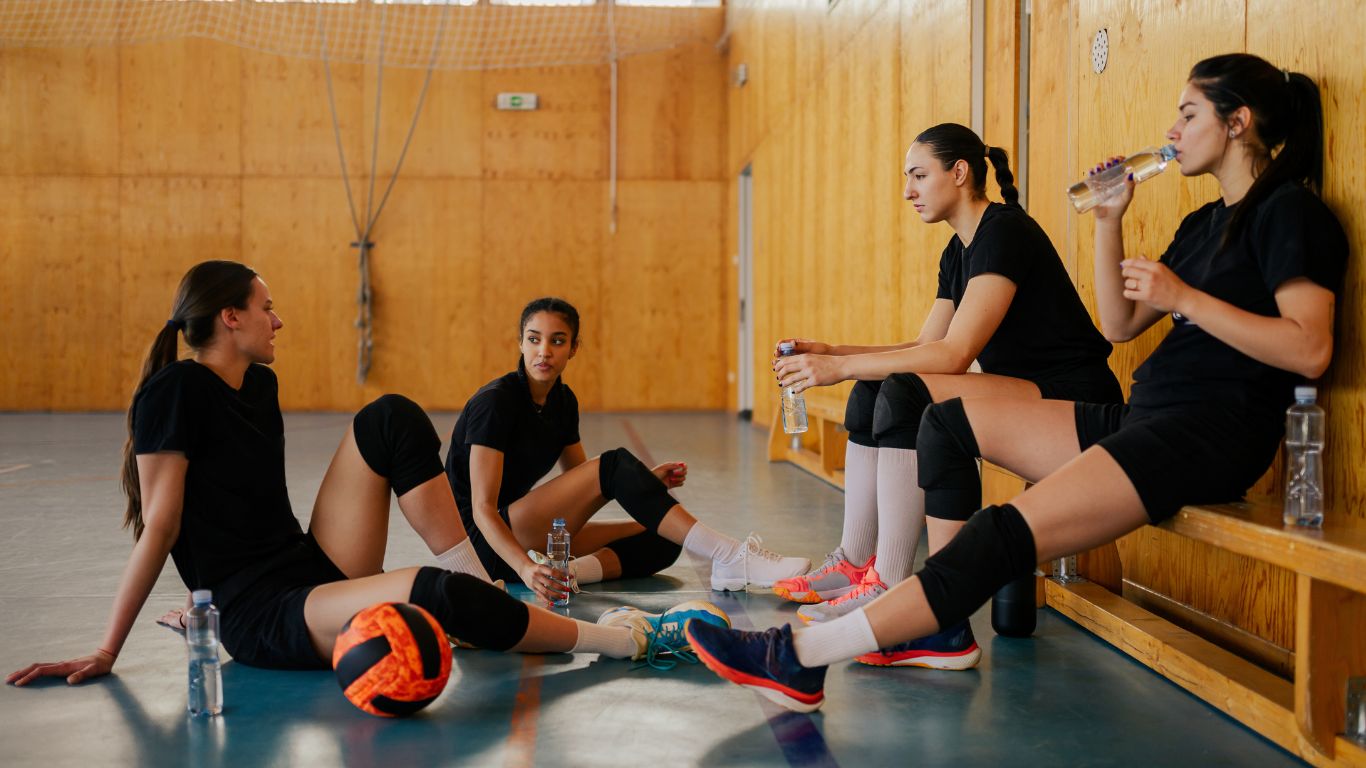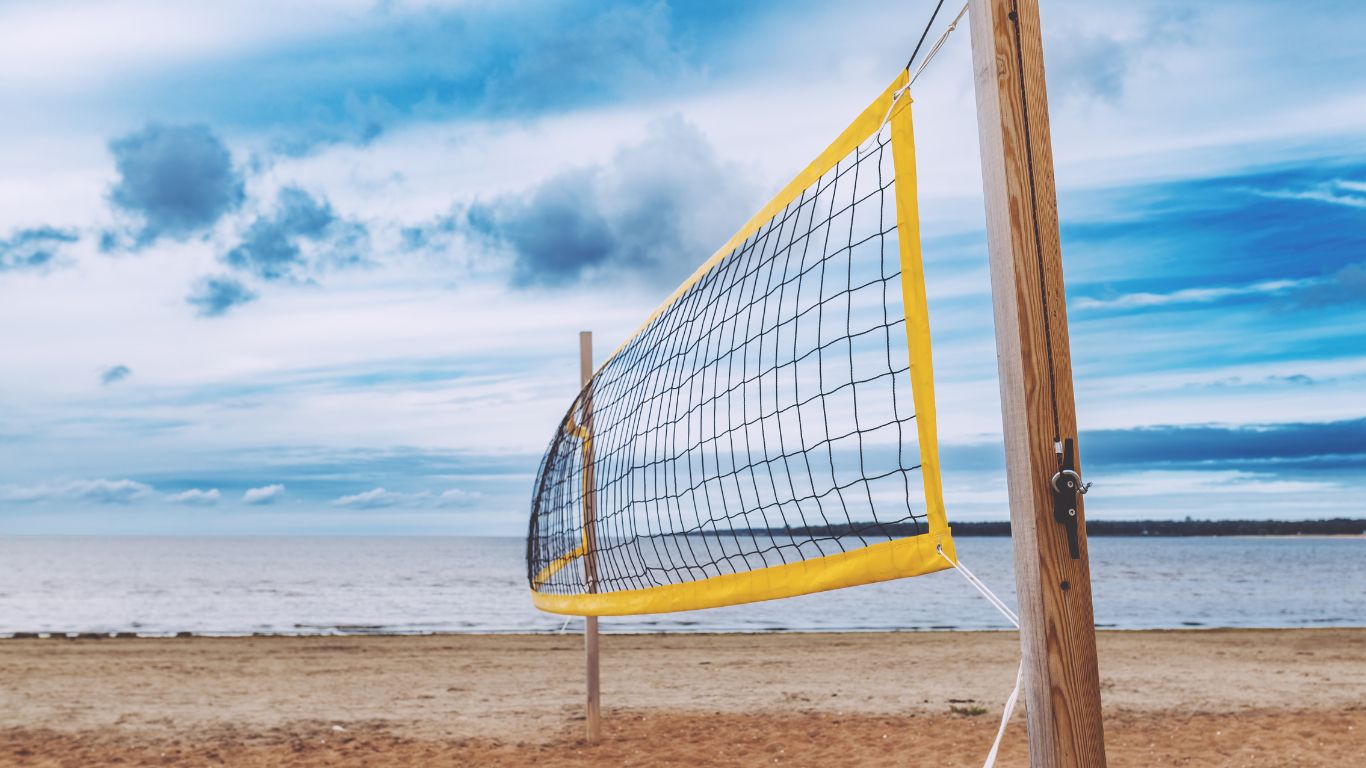To set a volleyball, position your hands as a diamond shape, make contact near the forehead, and push upwards using your wrists and fingers. The skill of setting in volleyball is crucial for effective offensive plays and accurate passes during the game.
Players must possess the ability to precisely direct the ball to their teammates while avoiding illegal lifts or carries. By following the proper technique and practice, anyone can improve their volleyball setting skills and contribute to their team’s success on the court.
We will guide you through the essential steps and provide tips to enhance your setting abilities. Let’s dive in and learn how to set a volleyball like a pro.
Setting Technique
Setting is a fundamental skill in volleyball that requires precision and finesse. It is the art of delivering the ball accurately to the intended hitter, setting them up for a successful attack. In this section, we will focus on the key elements of setting technique: hand position, footwork, timing, and contact point.
Hand Position
The position of your hands is crucial in setting as it determines the direction and height of the ball. To achieve the perfect hand position:
- Hold your hands in front of you with your fingers spread apart.
- Create a subtle, cushion-like shape by cupping your hands slightly.
- Keep your thumbs pointing towards each other and your wrists firm.
Footwork
Proper footwork is essential to maintain balance and stability while setting the ball. Follow these footwork techniques:
- Start in a balanced position with your feet shoulder-width apart.
- Step with your non-dominant foot towards the target.
- Plant your dominant foot alongside your non-dominant foot.
- Position your feet in line with the target to maintain accuracy.
Timing
Timing is everything when it comes to setting. It involves anticipating the ball’s trajectory and reaching the optimal position to make a successful set. Focus on the following timing tips:
- Keep your eyes on the ball from the moment it leaves the passer’s hands.
- Move towards the ball as quickly as possible without sacrificing accuracy.
- Extend your arms and jump at the right moment to make contact with the ball.
Contact Point
The contact point is where your hands make contact with the ball during the setting motion. Pay attention to the following:
- Strive for a clean, controlled contact with your fingertips and the pads of your palms.
- Avoid hitting the ball too hard or soft; aim for a gentle touch.
- Make sure your fingers are spread evenly across the ball for maximum control.
By mastering the setting technique and focusing on hand position, footwork, timing, and contact point, you will be well on your way to becoming a skilled setter. Practice these fundamentals consistently, and you’ll witness a significant improvement in your setting abilities.

Common Setting Mistakes
Volleyball setting is a critical skill within the game, as it determines the accuracy and quality of the ball that is passed to the hitter for an attack. However, even the most experienced setters can make mistakes that can impact the play. Let’s explore the common setting mistakes and ways to avoid them.
Misalignment With The Hitter
Misalignment with the hitter can significantly affect the success of a set. If the setter is not properly aligned with the hitter, it becomes challenging for the hitter to make a powerful attack. A common mistake is setting the ball too far in front or behind the hitter, making it difficult for them to connect with the ball in the optimal hitting zone.
To avoid misalignment:
- Position yourself opposite the hitter, ensuring that you are facing them directly.
- Pay attention to the hitter’s approach and adjust your positioning accordingly.
- Communicate with the hitter to understand their preferences and adjust your sets accordingly.
Poor Hand Position
Hand position plays a crucial role in setting the volleyball accurately. Incorrect hand positioning can result in an inconsistent and unreliable set. One common mistake is having your hands too close together, which can lead to a restricted range of motion and less control over the ball. On the other hand, having your hands too far apart can cause the ball to veer off course.
To maintain proper hand position:
- Keep your fingers spread apart, creating a wide platform for the ball to rest upon.
- Position your hands just above your forehead, using your fingertips and thumbs to form a triangle shape.
- Maintain a soft grip on the ball, allowing for proper contact and control.
Incorrect Footwork
Footwork is often overlooked in setting, but it plays a vital role in setting up the ball accurately. Setting with incorrect footwork can lead to a lack of power, balance issues, and inconsistent sets. One common mistake is not using the proper footwork pattern, resulting in less control and accuracy.
To ensure correct footwork:
- Start with your feet shoulder-width apart and your knees slightly bent.
- Step forward with your non-dominant foot as you set the ball, using a small shuffle step.
- Maintain balance by distributing your weight evenly on both feet throughout the set.
Lack Of Communication
Communication is vital in any team sport, and volleyball is no exception. A lack of communication between the setter and the hitter can lead to missed opportunities or miscommunications, resulting in poor sets and unsuccessful attacks. It is the responsibility of both the setter and the hitter to establish clear communication for successful plays.
To improve communication:
- Establish hand signals or verbal cues to indicate the desired set.
- Develop trust and understanding with your hitter through practice and familiarity.
- Regularly communicate and provide feedback to ensure a strong connection on the court.
Drills To Improve Setting
Improving your setting skills is crucial to becoming a valuable player on the volleyball court. The more precise and accurate your sets are, the easier it will be for your teammates to spike the ball and score points. To help you enhance your setting technique, here are some effective drills that you can practice:
Wall Drills
Wall drills are a fantastic way to refine your setting technique and work on your hand-eye coordination. Find a sturdy wall and stand approximately two feet away from it. Position yourself in a setting stance, with your hands extended in front of you as if you were setting a ball. Start throwing the volleyball against the wall and focus on properly contacting the ball with your fingertips. Pay attention to the angle and power of your sets, aiming to consistently hit the target on the wall.
Partner Toss
Partner toss drills are an excellent means of simulating game-like scenarios and developing a good rapport with your teammates. Find a partner and stand facing each other, about six to ten feet apart. Begin by tossing the ball back and forth, practicing your sets in a controlled and consistent manner. Concentrate on your footwork, hand positioning, and timing when releasing the ball. Through regular repetition, you will improve your setting accuracy and coordination with your partner.
Mirror Drill
The mirror drill is a highly effective exercise that allows you to observe your technique and make necessary adjustments. Set up a mirror in front of you, ensuring you have a clear view of your body and hand movements. Begin practicing your sets, paying attention to your positioning, footwork, and hand placement. As you watch yourself in the mirror, notice any errors or areas for improvement. This visual feedback will help you correct any mistakes and refine your setting mechanics.
Setting Challenges
Setting challenges add an element of competitiveness to your training sessions, pushing you to improve your setting under pressure. Create various setting challenges by setting up targets on the court, such as hula hoops or cones, at different distances and angles. Challenge yourself to hit these targets consistently with accurate sets. You can also incorporate time limits or team competitions to make it more exciting. These challenges will enhance your setting precision and teach you to perform well in game situations.
Setting In Different Situations
In volleyball, setting in different situations is essential for a well-rounded offense. By using various setting techniques, players can surprise the opposing team and create scoring opportunities. Let’s explore some crucial setting techniques in different situations:
Quick Sets
Quick sets are performed close to the net, involving a fast and precise delivery to the hitter. This technique catches the opposing team off-guard, making it challenging for them to set up a block. Timing and coordination between the setter and hitter are critical for executing successful quick sets.
Back Sets
Back sets involve setting the ball to a hitter positioned behind the setter. This technique enables the hitter to approach the ball from a different angle, making it harder for the opponents to predict the play. It requires a skilled setter who can accurately deliver the ball to the designated hitter.
Shoot Sets
Shoot sets are executed by directing the ball at a sharp angle to a hitter who is running parallel to the net. This unpredictable play catches defenders off-guard, creating an opportunity for the hitter to score. Precision and timing are crucial for the setter to execute successful shoot sets.
Option Sets
Option sets involve the setter providing multiple hitting options to confuse the opponent’s blockers. The setter disguises the intended hitter until the last possible moment, making it challenging for the defense to predict the play. This technique requires excellent communication and teamwork between the setter and hitters.
Setting Strategies
Volleyball is a game of precision and strategy, and setting the ball effectively can be the difference between winning and losing a point. By employing strategic setting techniques, players can outsmart their opponents and set up their teammates for success. Here are some effective setting strategies that can elevate your game:
Using Fakes
Faking a set can be a powerful tool to mislead the opposition. By using body movements and hand gestures to confuse defenders, you can create opportunities for your hitters. Effective use of fakes can make the blockers commit early, allowing your teammates to exploit the openings created. Confidence and deceptive movements are key to executing fakes successfully.
Deceiving The Blockers
Deceiving blockers is a crucial skill for setters. By altering the tempo and trajectory of your sets, you can create uncertainty among the opposition blockers. Varying the angle and speed of your sets can force the blockers to guess and mistime their jumps, leaving them vulnerable to attacking shots. Observing the blockers’ movements and adapting your sets accordingly can be instrumental in outsmarting the defense.

Credit: www.theartofcoachingvolleyball.com
Setting As A Team
Setting in volleyball is a crucial skill that requires teamwork and coordination. As the setter, it is your responsibility to deliver accurate and well-timed sets to your teammates. But setting is not a one-person show—it requires effective communication, trust and timing, and coordination with hitters to achieve success. In this article, we will explore these key aspects of setting as a team and provide some tips to improve your overall performance.
Communication
Effective communication is the foundation of any successful volleyball team. As a setter, you need to communicate with your teammates constantly to ensure everyone is on the same page. Here are some ways to improve communication during a volleyball match:
- Use clear and concise hand signals and verbal cues to indicate your intended set.
- Establish a system of calling out plays or strategies to keep your teammates informed.
- Maintain an open line of communication with your hitters, asking for feedback and adjusting your sets accordingly.
By consistently communicating with your team, you can create a seamless connection on the court and maximize your chances of success.
Trust And Timing
Trust and timing go hand in hand when it comes to setting in volleyball. As a setter, you must trust your hitters to be in the right position and ready for your sets. Likewise, your hitters must trust your ability to deliver accurate and well-timed sets. Here’s how you can build trust and improve timing:
- Practice with your teammates regularly to develop a strong rapport and understanding of each other’s playing styles.
- Study your hitters’ movements and preferences, so you can anticipate their needs and set accordingly.
- Work on your timing by practicing quick and efficient footwork, enabling you to reach the ball and set it accurately.
Building trust and improving timing requires time and effort, but the results will be evident in your team’s performance on the court.
Coordination With Hitters
Coordination with hitters is essential for successful setting. As the setter, you need to ensure that your sets complement the hitting style and preferences of your teammates. Here are some tips to enhance your coordination with hitters:
- Communicate with your hitters about their preferred sets, such as quick sets, high sets, or back sets.
- Observe how your hitters approach the ball during practice to better understand their positioning and timing.
- Adjust your sets based on the positioning and readiness of your hitters, delivering the ball where they can attack it with power and accuracy.
By coordinating effectively with your hitters, you can create a powerful and coordinated offense that keeps the opposing team on their toes.
Setting in volleyball is a team effort that requires open communication, trust and timing, and coordination with hitters. By focusing on these aspects, you can become a more effective setter and contribute to your team’s success on the court.
Setting For Success
When it comes to volleyball, setting plays a crucial role in determining the success of each team. A well-executed set can make all the difference in delivering a powerful attack or setting up a solid defense. In this article, we will explore the key aspects of setting that contribute to consistent and adaptable play. By focusing on consistency, adaptability, and regular practice, you can hone your setting skills and elevate your game to new heights.
Consistency
Consistency is the foundation of effective setting. Consistency allows your teammates to anticipate the trajectory and timing of the ball, enabling them to approach their attack or defense with precision. When setting, aim for a consistent release point, weight distribution, and hand positioning. By maintaining consistency in these areas, you will create a reliable and predictable connection with your hitters.
Additionally, developing a consistent tempo in your sets is crucial. This means finding a rhythm that suits your team’s style of play and enables your hitters to time their attacks accurately. Whether it’s a fast-paced set for a quick attack or a slower tempo set for a well-placed tip, maintaining consistency in your tempo will keep the opposing team guessing and give your hitters an advantage.
Adaptability
While consistency is vital, being adaptable in your setting is equally important. Every situation on the court is unique, and you must be ready to adjust your technique accordingly. As a setter, you need to adapt to the speed and positioning of the pass coming your way. This may require you to move quickly, adjust your footwork, or change the angle of your hands to deliver an accurate set.
Furthermore, adaptability extends beyond just your technique. It also involves understanding the strengths and preferences of your hitters. Each player has a different approach, and being adaptable means tailoring your sets to suit their individual needs. This may involve adjusting the height, speed, or location of your sets, allowing your hitters to maximize their hitting potential.
Practice
To excel in setting, practice is essential. The more you practice, the more comfortable and confident you will become in executing your sets. Set aside dedicated time during each practice session to focus solely on your setting skills. Incorporate drills that simulate game situations, such as setting from different positions or under varying levels of pressure.
- Practice consistency by aim to hit the same spot on the court with every set.
- Practice adaptability by varying the speed and location of your sets to challenge yourself and simulate different game scenarios.
- Seek feedback from your coach or teammates to identify areas for improvement and make necessary adjustments.
Remember, setting is a skill that requires constant refinement. The more you practice and expose yourself to different situations, the more adaptable and confident you will become, ultimately leading to greater success on the volleyball court.

Credit: www.youtube.com
Frequently Asked Questions
How Do You Set A Volleyball Step By Step?
To set a volleyball, follow these steps: 1. Position your body with your feet shoulder-width apart and knees slightly bent. 2. Form a triangle with your thumbs and pointer fingers, creating a platform for the ball. 3. Watch the ball and move your arms to meet it as it comes towards you.
4. Keep your wrists firm and absorb the impact of the ball with your forearms. 5. Direct the ball towards your target by extending your arms and using your legs for power.
What Fingers Do You Use To Set A Volleyball?
To set a volleyball, use your fingers. Specifically, use your fingertips and the pads of your fingers to make contact with the ball.
How Do I Become A Good Setter?
To become a good setter, practice precise hand positioning, focus on footwork, and work on developing consistent and accurate sets. Communication with teammates and observing professional setters can also help improve your skills. Regular practice and determination are key to becoming a proficient setter.
What Is The Ideal Set In Volleyball?
The ideal set in volleyball is a precise, controlled contact with the ball, leading to a perfect pass for the hitter to spike. It requires accuracy, timing and coordination among players to execute successfully.
Conclusion
Setting a volleyball requires proper technique, focus, and practice. By following the step-by-step guide provided in this blog post, you can enhance your setting skills and contribute to your team’s success. Remember to maintain a relaxed but firm grip on the ball, use your fingers to guide the ball’s placement, and communicate effectively with your teammates.
Elevating your setting game will undoubtedly improve your overall performance on the volleyball court. Happy setting!









